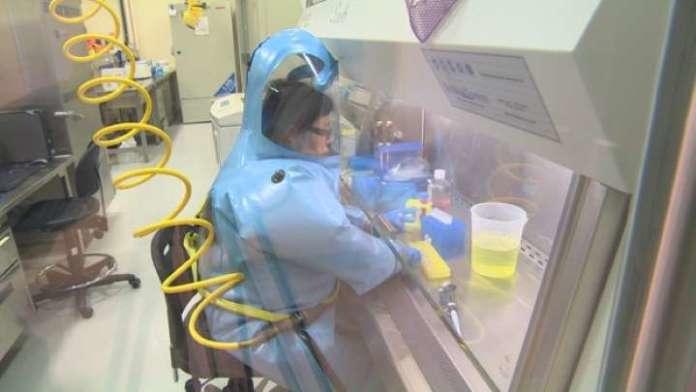That hasn’t stopped an outbreak of nonsense and conspiracy theories. On Sunday, the
Washington Times — a paper with a
distinct ideological bent
— published an article claiming that the virus’ outbreak could be linked to a military lab in Wuhan.
The article suggests a government-run lab, the Wuhan Institute of Virology, could have been researching military applications for the coronavirus and may have been the source of the outbreak.
The only basis for the claim is a quote from former Israeli intelligence officer Dany Shoham, who has expertise in biological warfare.
“Certain laboratories in the institute have probably been engaged, in terms of research and development, in Chinese [biological weapons], at least collaterally, yet not as a principal facility of the Chinese BW alignment,” Shoham told the
Times.
While Shoham never backed up the claim made in the story that the outbreak stemmed from a biological weapon, other outlets nevertheless picked up the idea and ran with it.
The Texas radio station KPRC posted the story to its
site, concluding “some intelligence experts believe the Chinese military’s biowarfare department may be responsible.” A speculation by a single former officer had become “intelligence experts.” The
Toronto Sun columnist Candice Malcolm pumped the theory on her YouTube
show, asking: “Why isn’t the mainstream media talking about the origins of this deadly virus? Could it be linked to China’s biological warfare program?”
All this on the guesswork of one man—and it’s not the first time Shoham has pumped the tires on a theory without much merit. In 2017, he went on Radio Sputnik, a propaganda arm of the Russian government, to
suggest the Islamic State had likely passed on chemical weapon capabilities to its sleeper cells in the West.
GreatGameIndia, a small conspiracy website— which, among other things, has reported that British intelligence was responsible for the downing of Malaysia Airlines Flight 17 over Ukraine in 2014—began publishing
reports last week claiming that Canadian researchers had sold this strain of coronavirus to China.
The co-founder and editor of the website has also written extensively for the Centre for Research on Globalization, a Montreal-based site that has been
identified by NATO as a peddler of Russian and Syrian propaganda.
The website pointed blame at Xiangguo Qiu, a former researcher with the National Microbiology Laboratory in Winnipeg, Manitoba, a government-run lab that has pioneered vaccines and treatments for various infectious diseases, including Ebola. While it’s true she was escorted from the lab last year by the Royal Canadian Mounted Police, there does not appear to be a national security element to the incident.
Charges have not been laid, and those familiar with the case say it is likely a matter of paperwork and protocol. Qiu, in fact, worked extensively with labs in China to create treatments for deadly and infectious diseases.
While the claims made on
GreatGameIndia are demonstrably untrue—the supposed shipment of the coronavirus in 2018 was for, in fact, for the MERS strain, not the novel coronavirus currently seen in Wuhan—it nevertheless got picked up by fellow conspiracy site
ZeroHedge, which has a massive following (about 670,000 Twitter followers and millions of visitors to its blog). Its
post on the baseless theory has been shared more than 6,000 times on Facebook and tweeted by hundreds of accounts, including by
Toronto Sun columnist
Tarek Fatah. The claims have since spread to a network of other less-than-reputable sites.
David Fisman, a professor of epidemiology at the University of Toronto’s Dalla Lana School of Public Health, said this coronavirus is definitely novel. And new viruses, especially those that move fast, can cause panic. Panic leads to people “casting about for conspiracy theories,” he said. But diseases that quickly mutate and infect humans are simply part of nature. “Welcome to emerging infectious diseases,” he told
Foreign Policy.
And this bioweapon speculation isn’t exactly new. In 2003, during the SARS outbreak, the Jamestown Foundation think tank
published an analysis suggesting “there are compelling reasons, however unsettling, to at least ask whether there might be any linkage between SARS and China’s biological warfare efforts.” That claim ultimately proved baseless.
The bioweapon fears aren’t the only ones out there.
BuzzFeed News has already put together a
list of 19 myths, fake images, and total falsehoods relating to the coronavirus outbreak.
Prepper websites, targeting those who obsessively prepare for the apocalypse and other widespread emergencies, have
exploded with news of the outbreak, warning that the outbreak could rival that of the Spanish flu.
Infowars, the conspiracy site run by Alex Jones that has previously
received the endorsement of U.S. President Donald Trump, has also been quick to spread lies and invented numbers about the outbreak.
On Reddit, multiple channels devoted to the coronavirus outbreak have popped up, and they have quickly become hubs for panic and half-baked concern.
Users on the coronavirus subreddit have been posting
details of
flights originating from China and have been encouraging others to stockpile goods. One user began creating graphs modeling the outbreak in exponential terms and concluding that the “real” death toll (based on social media) is in fact over 8,000. The user’s graphs, which have begun spreading on social media, assert there will be 11.5 million cases of the coronavirus by next month, with over 800,000 dead.
“This is terrifying,” Fisman acknowledged. “But exponential growth is what happens if you leave these processes alone and don’t do anything about them.”
It’s called Farr’s Law, named for a famed British epidemiologist. It holds that, as human behavior changes in the midst of a disease outbreak and health agencies take action, transmissions level off and then decline. While it’s been misapplied in the past, it is a good predictor of how outbreaks can be stopped.
Looking at the graph in question, Fisman said it’s irresponsible to be spreading that sort of misinformation. “Curves don’t look like this. Because we do things about them.”
While the coronavirus is undoubtedly spreading fast, it is worth putting the numbers in context.
There have been nearly
100,000 cases of influenza A and B, which cause the flu, in the United States since the flu season began in late September 2019—including 54 deaths of children.
It’s still not clear how this outbreak of the coronavirus compares to SARS and MERS, but both outbreaks provide some frame of reference. The SARS outbreak of November 2002, which continued until the following July, resulted in more than
8,000 cases and about 775 deaths in more than two dozen countries—the response to that outbreak was marred by a late response and Beijing’s effort to control information to hide the extent of the virus’ reach. MERS, meanwhile, was first discovered in the Persian Gulf in 2012 and since then has seen sporadic clusters of cases. Over the past eight years, there have been nearly
2,500 confirmed cases and more than 850 deaths spread out over more than two dozen countries.
For SARS, the R0 value—a number that estimates how many others each infected person could pass the virus onto—
sat somewhere between 2 and 5. For the new coronavirus, the R0 value appears to be similar, but lower, Nancy Messonnier, the director of U.S. Centers for Disease Control and Prevention’s National Center for Immunization and Respiratory Disease, said in a media briefing Monday. “Most articles have had interpretation that the R0 is somewhere 1.5 and 3,” Messonnier said.
To just look at the R0 value can be troubling, but that number doesn’t tell the whole story.
R_0 estimates for #SARS are 2 to 5, whereas they’re only about 1.3 on average for seasonal #flu. The latter causes millions of cases a year whereas the former didn’t even cause [10,000],” Maia Majumder, of Boston Children’s Hospital’s Computational Health Informatics Program,
tweeted Saturday.
Speaking to
Foreign Policy, Majumder said that just because the coronavirus has had an R0 value of, say, 2 in China before the public was alerted to its existence doesn’t mean it will continue to have that value. “It shouldn’t be treated as a constant of nature; it varies considerably from place to place because of social practices, environmental differences, and so on,” she said.
It does appear that the virus has spread faster than originally thought. Researchers in Hong Kong estimate that the real number of infections
could be over 40,000 in Wuhan alone. Fisman says that’s “the right order of magnitude” (he personally thinks the actual number of cases is closer to 15,000) but notes there’s another side to that.
“If we’re missing a whole bunch of cases … well that means your cumulative case fatality is too high,” Fisman said. In other words: If the undiagnosed cases are so mild that infected people don’t know they’re infected, it does mean the scope of the outbreak is wider, but that it is less lethal than the confirmed case count would suggest. (There are real concerns that the dead are
being undercounted, but not on the scale that some conspiracy theorists, who have made claims of thousands dead, have suggested without proof.)
Part of the basis for suggesting that the infected number may be multiples higher than originally thought stems from speculation that the virus can transmit even when those infected are asymptomatic, or that those infected are contagious for longer than normal. That comes from statements from the Chinese health authority, which indicated the virus has gotten more powerful. Chinese Health Minister Ma Xiaowei
said the incubation period could be as long as 14 days. Fisman said the research to date doesn’t support that claim, and he said the incubation period looks more like that of SARS, at around six days. He suggested that, as the virus can be mild in some infected people, they may not even know they’re symptomatic—children, for example, may run around and play, oblivious to their runny nose.
The CDC, similarly, says there is no evidence to support the idea that asymptomatic people are contagious.
There are fears that the paranoia and panic could push some to profile all Asians as being vectors of disease.
“What’s very concerning to me … is how easily those rumors can lead to inappropriate discrimination against people, and we need to take all those rumors with a grain of salt and recognize that they are just that: rumors,” British Columbia Health Officer Bonnie Henry told reporters on Tuesday, in announcing her province’s first case.
Discrimination is already occurring in China, where citizens with registration cards from Hubei are being forcibly quarantined or refused entry into public spaces or transportation—even if they haven’t been home in months or years. As the Trump administration mulls possible travel bans and neighboring countries
begin to
close their borders, that paranoia may spread.



 Sources say
Sources say  Dr. Gary Kobinger, former chief of special pathogens (right), and Dr.
Dr. Gary Kobinger, former chief of special pathogens (right), and Dr.  The Wuhan National Biosafety Laboratory is located just about 20 miles away from the Huanan Seafood Market, the epicenter of Coronavirus outbreak
The Wuhan National Biosafety Laboratory is located just about 20 miles away from the Huanan Seafood Market, the epicenter of Coronavirus outbreak


